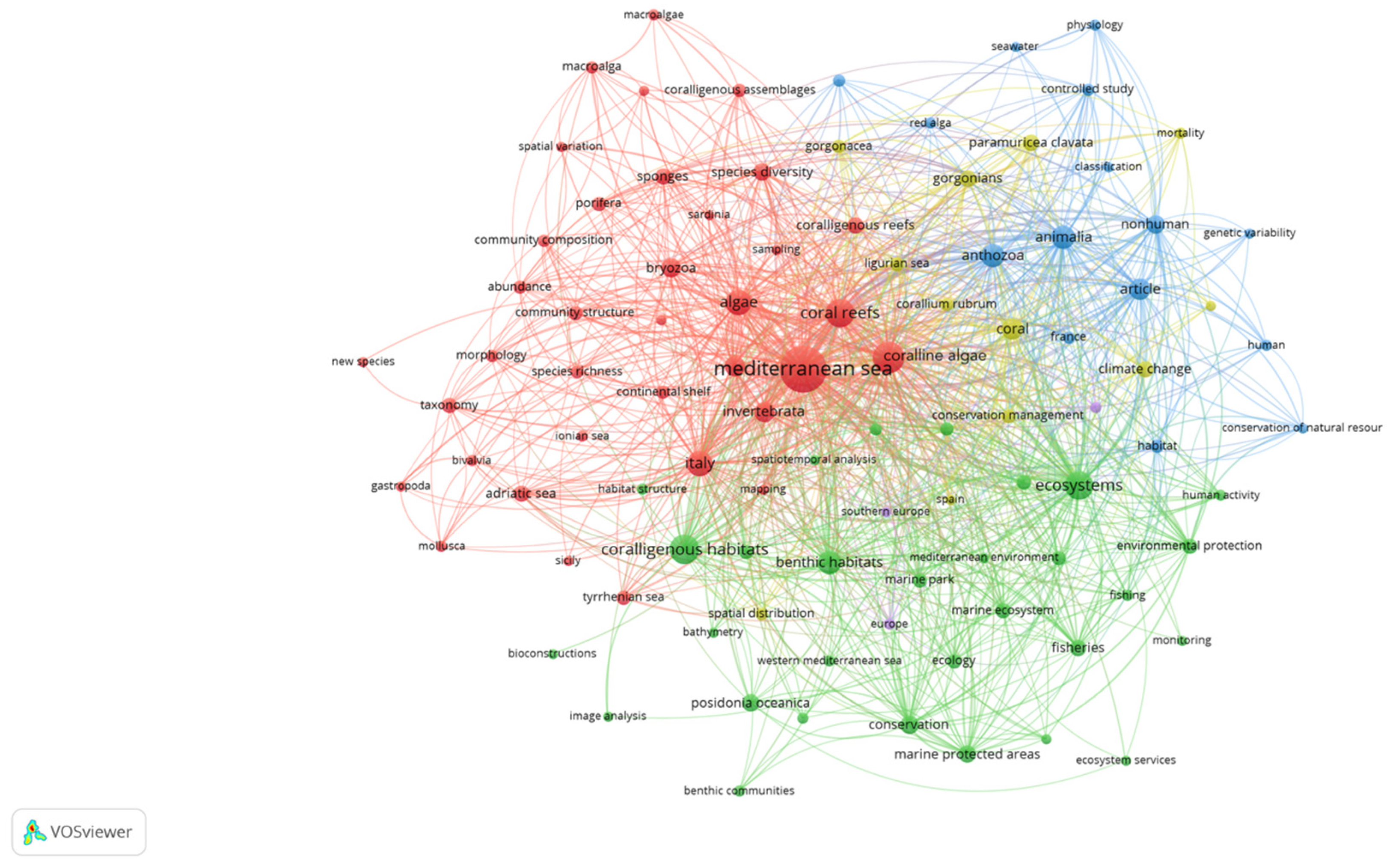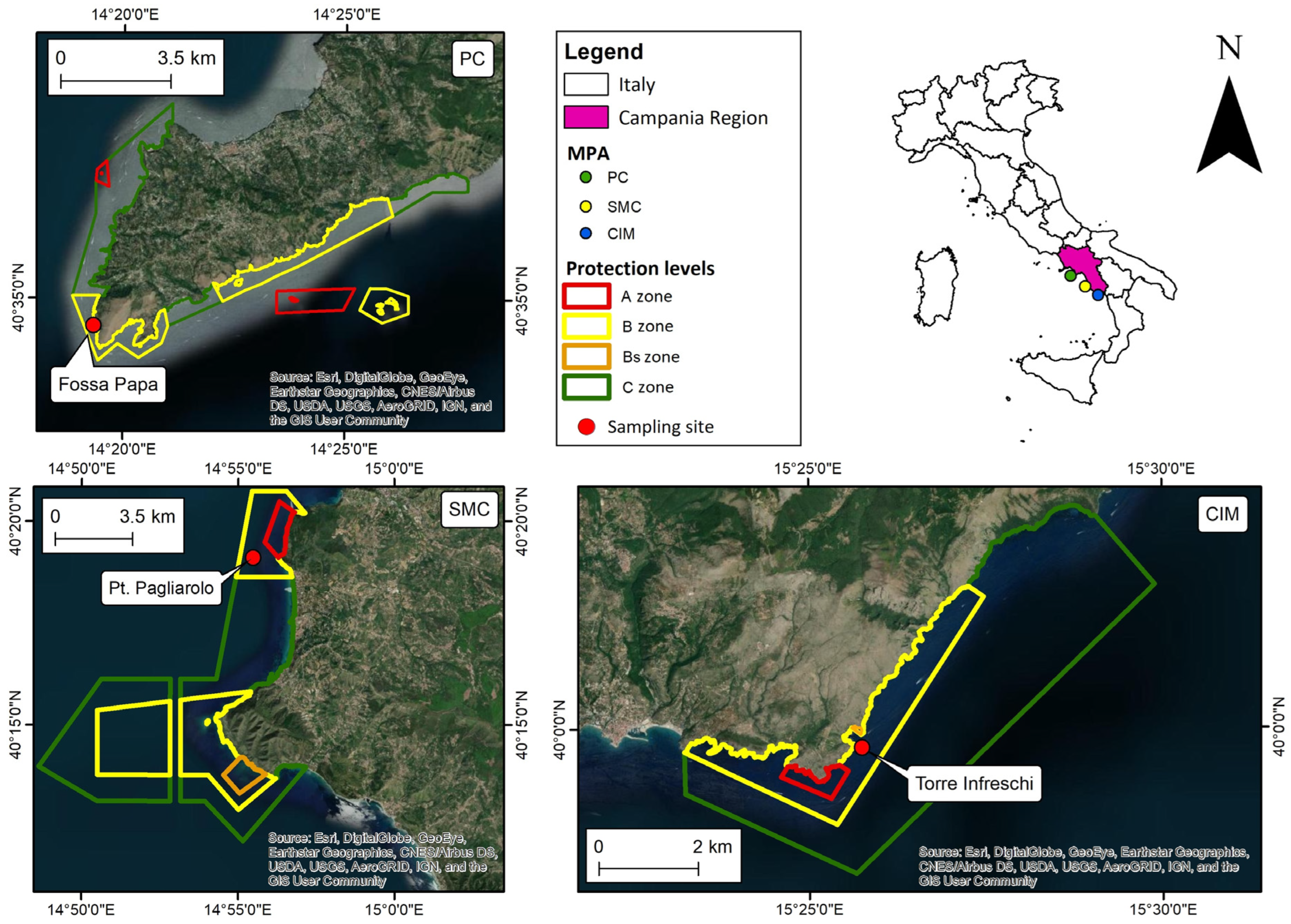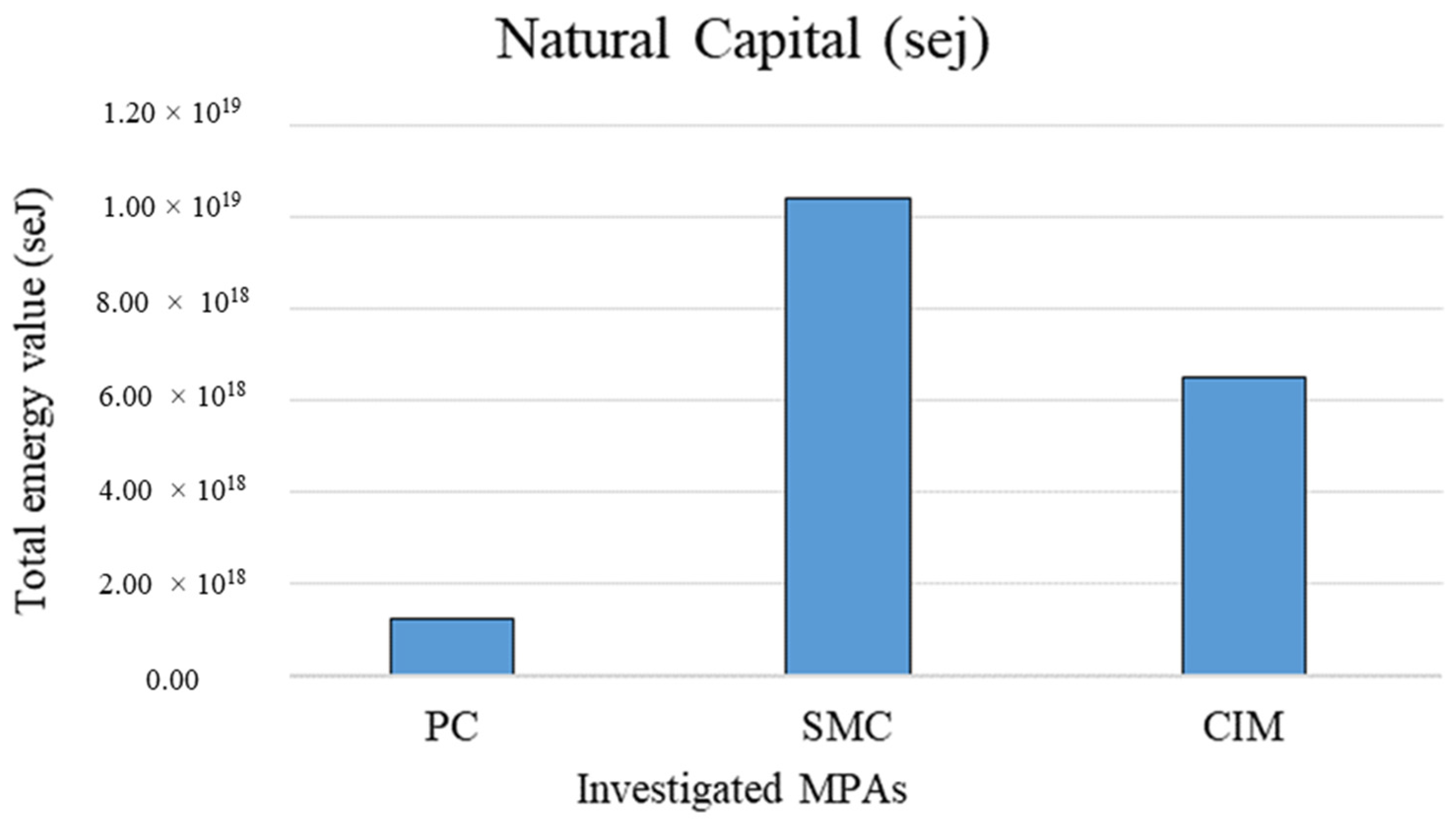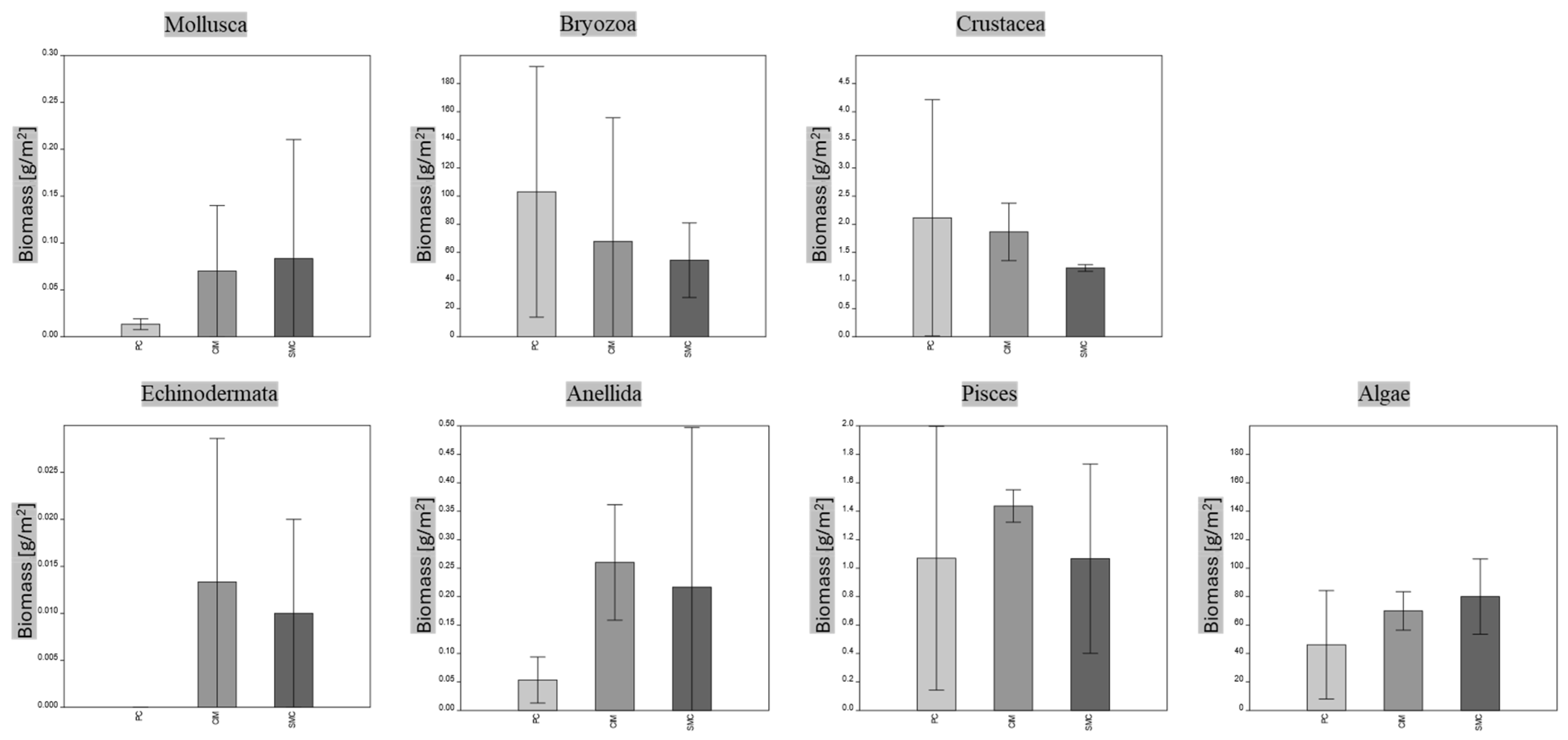Natural Capital Accounting of the Coralligenous Habitat in Marine Protected Areas
Abstract
1. Introduction
2. Materials and Methods
2.1. Study Area
2.2. Sampling Procedures and Data Analysis
2.3. The Emergy Accounting Method
- Identification of the spatial and temporal boundaries of the habitat in the three MPAs;
- Biomass inventory and trophodynamic analysis of the main taxonomic groups identified in the habitat of the three MPAs, providing an estimate of the primary productivity used to support the benthic trophic web within the study areas;
- Biophysical accounting, providing an estimate of the biophysical value of natural capital and environmental flows (in terms of matter and energy), converting them into solar emergy units;
- Monetary conversion, expressing the biophysical value of natural capital in monetary units.

2.4. Statistical Analysis
3. Results
4. Discussion
5. Conclusions
Author Contributions
Funding
Institutional Review Board Statement
Informed Consent Statement
Data Availability Statement
Acknowledgments
Conflicts of Interest
References
- Barbier, E.B.; Hacker, S.D.; Kennedy, C.; Koch, E.W.; Stier, A.C.; Silliman, B.R. The value of estuarine and coastal ecosystem services. Ecol. Monogr. 2011, 81, 169–193. [Google Scholar] [CrossRef]
- Rendina, F.; Buonocore, E.; di Montanara, A.C.; Russo, G.F. The scientific research on rhodolith beds: A review through bibliometric network analysis. Ecol. Inform. 2022, 70, 101738. [Google Scholar] [CrossRef]
- Buonocore, E.; Grande, U.; Franzese, P.P.; Russo, G.F. Trends and evolution in the concept of marine ecosystem services: An overview. Water 2021, 13, 2060. [Google Scholar] [CrossRef]
- European Commission. Directorate-General for Maritime Affairs and Fisheries, Joint Research Centre; Borriello, A., Calvo Santos, A., Ghiani, M., Eds.; The EU Blue Economy Report; Publications Office of the European Union: Brussels, Belgium, 2023. [Google Scholar]
- Ferrigno, F.; Rendina, F.; Sandulli, R.; Russo, G.F. Coralligenous assemblages: Research status and trends of a key Mediterranean biodiversity hotspot through bibliometric analysis. Ecol. Quest. 2024, 35, 1–32. [Google Scholar]
- Boudouresque, C.F. Marine biodiversity in the Mediterranean: Status of species, populations and communities. Trav. Sci. Parc Natl. Port-Cros 2004, 20, 97–146. [Google Scholar]
- Ballesteros, E.; Gibson, R.; Atkinson, R.; Gordon, J. Mediterranean coralligenous assemblages: A synthesis of present knowledge. Oceanogr. Mar. Biol. Annu. Rev. 2006, 44, 123–195. [Google Scholar]
- Martin, S.; Gattuso, J.P. Response of Mediterranean coralline algae to ocean acidification and elevated temperature. Glob. Chang. Biol. 2009, 15, 2089–2100. [Google Scholar] [CrossRef]
- Garrabou, J.; Ballesteros, E. Growth of Mesophyllum alternans and Lithophyllum frondosum (Corallinales, Rhodophyta) in the northwestern Mediterranean. Eur. J. Phycol. 2000, 35, 1–10. [Google Scholar] [CrossRef][Green Version]
- Cocito, S. Bioconstruction and biodiversity: Their mutual influence. Sci. Mar. 2004, 68, 137–144. [Google Scholar] [CrossRef]
- Lapointe, L.; Bourget, E. Influence of substratum heterogeneity scales and complexity on a temperate epibenthic marine community. Mar. Ecol. Prog. Ser. 1999, 189, 159–170. [Google Scholar] [CrossRef]
- Balata, D.; Piazzi, L.; Bulleri, F. Sediment deposition dampens positive effects of substratum complexity on the diversity of macroalgal assemblages. J. Exp. Mar. Biol. Ecol. 2015, 467, 45–51. [Google Scholar] [CrossRef]
- Ferrigno, F.; Appolloni, L.; Rendina, F.; Donnarumma, L.; Russo, G.F.; Sandulli, R. Red coral (Corallium rubrum) populations and coralligenous characterization within “Regno di Nettuno MPA” (Tyrrhenian Sea, Italy). Eur. Zool. J. 2020, 87, 203–213. [Google Scholar] [CrossRef]
- Deter, J.; Descamp, P.; Boissery, P.; Ballesta, L.; Holon, F. A rapid photographic method detects depth gradient in coralligenous assemblages. J. Exp. Mar. Biol. Ebarbiercology 2012, 418–419, 75–82. [Google Scholar] [CrossRef]
- Piazzi, L.; Gennaro, P.; Balata, D. Threats to macroalgal coralligenous assemblages in the Mediterranean Sea. Mar. Pollut. Bull. 2012, 64, 2623–2629. [Google Scholar] [CrossRef] [PubMed]
- Piazzi, L.; Bianchi, C.N.; Cecchi, E.; Gatti, G.; Guala, I.; Morri, C.; Sartoretto, S.; Serena, F.; Montefalcone, M. What’s in an index? Comparing the ecological information provided by two indices to assess the status of coralligenous reefs in the NW Mediterranean Sea. Aquat. Conserv. Mar. Freshw. Ecosyst. 2017, 27, 1091–1100. [Google Scholar] [CrossRef]
- Sartoretto, S.; Schohn, T.; Bianchi, C.N.; Morri, C.; Garrabou, J.; Ballesteros, E.; Gatti, G. An integrated method to evaluate and monitor the conservation state of coralligenous habitats: The INDEX-COR approach. Mar. Pollut. Bull. 2017, 120, 222–231. [Google Scholar] [CrossRef]
- Gatti, G.; Bianchi, C.N.; Parravicini, V.; Rovere, A.; Peirano, A.; Montefalcone, M.; Massa, F.; Morri, C. Ecological change, sliding baselines and the importance of historical data: Lessons from combining observational and quantitative data on a temperate reef over 70 years. PLoS ONE 2015, 10, e0118581. [Google Scholar] [CrossRef]
- Gambi, M.C.; Barbieri, F.; Signorelli, S.; Saggiomo, V. Mortality events along the Campania coast (Tyrrhenian Sea) in summers 2008 and 2009 and relation to thermal conditions. Biol. Mar. Mediterr. 2010, 17, 126–127. [Google Scholar]
- Bavestrello, G.; Bo, M.; Canese, S.; Sandulli, R.; Cattaneo-Vietti, R. The red coral populations of the gulfs of Naples and Salerno: Human impact and deep mass mortalities. Ital. J. Zool. 2014, 81, 552–563. [Google Scholar] [CrossRef]
- Bo, M.; Bava, S.; Canese, S.; Angiolillo, M.; Cattaneo-Vietti, R.; Bavestrello, G. Fishing impact on deep Mediterranean rocky habitats as revealed by ROV investigation. Biol. Conserv. 2014, 171, 167–176. [Google Scholar] [CrossRef]
- Gómez-Gras, D.; Linares, C.; Dornelas, M.; Madin, J.S.; Brambilla, V.; Ledoux, J.B.; Garrabou, J. Climate change transforms the functional identity of Mediterranean coralligenous assemblages. Ecol. Lett. 2021, 24, 1038–1051. [Google Scholar] [CrossRef] [PubMed]
- Cerrano, C.; Bavestrello, G.; Bianchi, C.N.; Cattaneo-Vietti, R.; Bava, S.; Morganti, C.; Morri, C.; Picco, P.; Sara, G.; Schiaparelli, S.; et al. A catastrophic mass-mortality episode of gorgonians and other organisms in the Ligurian Sea (North-western Mediterranean), summer 1999. Ecol. Lett. 2000, 3, 284–293. [Google Scholar] [CrossRef]
- Garrabou, J.; Perez, T.; Sartoretto, S.; Harmelin, J.G. Mass mortality event in red coral Corallium rubrum populations in Provence region (France, NW Mediterranean). Mar. Ecol. Prog. Ser. 2001, 217, 263–272. [Google Scholar] [CrossRef]
- Bramanti, L.; Magagnini, G.; De Maio, L.; Santangelo, G. Recruitment, early survival and growth of the Mediterranean red coral Corallium rubrum (L. 1758), a 4-year study. J. Exp. Mar. Biol. Ecol. 2005, 314, 69–78. [Google Scholar] [CrossRef]
- Bramanti, L.; Movilla, J.; Guron, M.; Calvo, E.; Gori, A.; Dominguez-Carrió, C.; Grinyò, J.; Lopez-Sanz, A.; Martinez-Quintana, A.; Pelejero, C.; et al. Detrimental effects of ocean acidification on the economically important Mediterranean red coral (Corallium rubrum). Glob. Chang. Biol. 2013, 19, 1897–1908. [Google Scholar] [CrossRef]
- Lombardi, C.; Rodolfo-Metalpa, R.; Cocito, S.; Gambi, M.C.; Taylor, P.D. Structural and geochemical alterations in the Mg calcite bryozoan Myriapora truncata under elevated seawater pCO2 simulating ocean acidification. Mar. Ecol. 2011, 32, 211–221. [Google Scholar] [CrossRef]
- Giuliani, S.; Lamberti, C.V.; Sonni, C.; Pellegrini, D. Mucilage impact on gorgonians in the Tyrrhenian sea. Sci. Total Environ. 2005, 353, 340–349. [Google Scholar] [CrossRef]
- Boudouresque, C.F.; Meinesz, A.; Ballesteros, E.; Ben Maiz, N.; Boisset, F.; Cinelli, F.; Cirik, S.; Cormaci, M.; Jeudy de Grissac, A.; Laborel, J.; et al. Livre Rouge “Gérard Vuignier” des Végétaux, Peuplements et Paysages Marins Menacés de Méditerranée; MAP Technical Report Series 1990, 43. Athens: UNEP/IUCN/GIS Posidonie; IUCN: Gland, Switzerland, 1990; pp. 1–250. [Google Scholar]
- Ingrosso, G.; Abbiati, M.; Badalamenti, F.; Bavestrello, G.; Belmonte, G.; Cannas, R.; Boero, F. Mediterranean bioconstructions along the Italian coast. Adv. Mar. Biol. 2018, 79, 61–136. [Google Scholar]
- European Commission. Directive 2008/56/EC of the European Parliament and of the Council of 17 June 2008 establishing a framework for Community action in the field of marine policy (Marine Strategy Framework Directive). Off. J. Eur. Union 2008, L164, 19–40. [Google Scholar]
- Buonocore, E.; Appolloni, L.; Russo, G.F.; Franzese, P.P. Assessing natural capital value in marine ecosystems through an environmental accounting model: A case study in Southern Italy. Ecol. Model. 2020, 419, 108958. [Google Scholar] [CrossRef]
- Appolloni, L.; Pagliarani, A.; Cocozza di Montanara, A.; Rendina, F.; Donnarumma, L.; Ciorciaro, D.; Ferrigno, F.; Di Stefano, F.; Sandulli, R.; Russo, G.F. Benthic Fish Communities Associated with Posidonia oceanica Beds May Reveal the Fishing Impact and Effectiveness of Marine Protected Areas: Two Case Studies in the Southern Tyrrhenian Sea. Water 2023, 15, 1967. [Google Scholar] [CrossRef]
- Catucci, E.; Buonocore, E.; Franzese, P.P.; Scardi, M. Assessing the natural capital value of Posidonia oceanica meadows in the Italian seas by integrating Habitat Suitability and Environmental Accounting Models. ICES J. Mar. Sci. 2023, 80, 739–750. [Google Scholar] [CrossRef]
- Council of the European Union. Council Directive 92/43/EEC of 21 May 1992 on the conservation of natural habitats and of wild fauna and flora. Off. J. Eur. Union 1992, L206, 7–50. [Google Scholar]
- Nandan, S.B.; Jayachandran, P.R.; Asha, C.V. Sampling Techniques for molluscan fauna. In Training Manual-1 St International Training Workshop On Taxonomy of Bivalve Molluscs; Cochin University of Science & Technology: Kochi, India, 2016; pp. 107–116. [Google Scholar]
- Brey, T.; Müller-Wiegmann, C.; Zittier, Z.M.; Hagen, W. Body composition in aquatic organisms—A global data bank of relationships between mass, elemental composition and energy content. J. Sea Res. 2010, 64, 334–340. [Google Scholar] [CrossRef]
- Harmelin-Vivien, M.L.; Harmelin, J.G.; Chauvet, C.; Duval, C.; Galzin, R.; Lejeune, P.; Lasserre, G. Evaluation visuelle des peuplements et populations de poissons méthodes et problèmes. Rev. D’ecol. Terre Vie 1985, 40, 467–539. [Google Scholar]
- Harmelin-Vivien, M.L.; Harmelin, J.G.; Leboulleux, V. Microhabitat requirements for settlement of juvenile sparid fishes on Mediterranean rocky shores. Hydrobiologia 1995, 300, 309–320. [Google Scholar] [CrossRef]
- Odum, H.T. Self organization, transformity and information. Science 1988, 242, 1132–1139. [Google Scholar] [CrossRef]
- Odum, H.T. Environmental Accounting: Emergy and Environmental Decision Making; John Wiley and Sons: Hoboken, NJ, USA, 1996; p. 369. [Google Scholar]
- Brown, M.T.; Ulgiati, S. Emergy analysis and environmental accounting. In Encyclopedia of Energy; Elsevier: Amsterdam, The Netherlands, 2004; p. 2. [Google Scholar]
- Brown, M.T.; Campbell, D.E.; De Vilbiss, C.; Ulgiati, S. The geobiosphere emergy baseline: A synthesis. Ecol. Model. 2016, 339, 89–91. [Google Scholar] [CrossRef]
- Kamp, A.; Morandi, F.; Østergård, H. Development of concepts for human labour accounting in Emergy Assessment and other Environmental Sustainability Assessment methods. Ecol. Indic. 2016, 60, 884–892. [Google Scholar] [CrossRef]
- Grande, U.; Piernik, A.; Nienartowicz, A.; Buonocore, E.; Franzese, P.P. Measuring natural capital value and ecological complexity of lake ecosystems. Ecol. Model. 2023, 482, 110401. [Google Scholar] [CrossRef]
- Vassallo, P.; Paoli, C.; Buonocore, E.; Franzese, P.P.; Russo, G.F.; Povero, P. Assessing the value of natural capital in marine protected areas: A biophysical and trophodynamic environmental accounting model. Ecol. Model. 2017, 355, 12–17. [Google Scholar] [CrossRef]
- Redfield, A.C. The influence of organisms on the composition of seawater. Sea 1963, 2, 26–77. [Google Scholar]
- Brown, M.T.; Ulgiati, S. Emergy-based indices and ratios to evaluate sustainability: Monitoring economies and technology toward environmentally sound innovation. Ecol. Eng. 1997, 9, 51–69. [Google Scholar] [CrossRef]
- Zhang, C.; Su, B.; Beckmann, M.; Volk, M. Emergy-based evaluation of ecosystem services: Progress and perspectives. Renew. Sustain. Energy Rev. 2024, 192, 114201. [Google Scholar] [CrossRef]
- Bracchi, V.A.; Bazzicalupo, P.; Fallati, L.; Varzi, A.G.; Savini, A.; Negri, M.P.; Rosso, A.; Sanfilippo, R.; Guido, A.; Bertolino, M.; et al. The Main Builders of Mediterranean Coralligenous: 2D and 3D Quantitative Approaches for its Identification. Front. Earth Sci. 2022, 10, 910522. [Google Scholar] [CrossRef]
- Casellato, S.; Stefanon, A. Coralligenous habitat in the northern Adriatic Sea: An overview. Mar. Ecol. 2008, 29, 321–341. [Google Scholar] [CrossRef]
- Casas-Güell, E.; Teixidó, N.; Garrabou, J.; Cebrian, E. Structure and biodiversity of coralligenous assemblages over broad spatial and temporal scales. Mar. Biol. 2015, 162, 901–912. [Google Scholar] [CrossRef]
- Enrichetti, F.; Bava, S.; Bavestrello, G.; Betti, F.; Lanteri, L.; Bo, M. Artisanal fishing impact on deep coralligenous animal forests: A Mediterranean case study of marine vulnerability. Ocean Coast. Manag. 2019, 177, 112–126. [Google Scholar] [CrossRef]
- Silva, S.; Grande, U.; Rendina, F.; Buonocore, E.; Guidato, M.; Contegiacomo, M.; Franzese, P.P. The scientific literature on coralligenous habitat and fishing impacts. Ecol. Quest. 2024, 35, 1. [Google Scholar] [CrossRef]
- Piazzi, L.; Cecchi, E.; Cinti, M.F.; Stipcich, P.; Ceccherelli, G. Impact assessment of fish cages on coralligenous reefs through the use of the STAR sampling procedure. Mediterr. Mar. Sci. 2019, 20, 627–635. [Google Scholar] [CrossRef]
- Franzese, P.P.; Buonocore, E.; Donnarumma, L.; Russo, G.F. Natural capital accounting in marine protected areas: The case of the Islands of Ventotene and S. Stefano (Central Italy). Ecol. Model. 2017, 360, 290–299. [Google Scholar] [CrossRef]
- Paoli, C.; Povero, P.; Burgos, E.; Dapueto, G.; Fanciulli, G.; Massa, F.; Scarpellini, P.; Vassallo, P. Natural capital and environmental flows assessment in marine protected areas: The case study of Liguria region (NW Mediterranean Sea). Ecol. Model. 2018, 368, 121–135. [Google Scholar] [CrossRef]






| Taxon | PC (gC m−2) | CIM (gC m−2) | SMC (gC m−2) |
|---|---|---|---|
| Mollusca | 6.68 | 8.97 | 6.65 |
| Bryozoa | 19.79 | 11.64 | 4.96 |
| Crustacea | 0.06 | 0.44 | 0.53 |
| Echinodermata | 0.01 | 0.10 | 0.05 |
| Anellida | 0.32 | 1.63 | 7.64 |
| Pisces | 54.69 | 31.66 | 23.79 |
| Algae | 472.88 | 435.61 | 553.17 |
| Input | PC | CIM | SMC |
|---|---|---|---|
| Emergy (sej) | Emergy (sej) | Emergy (sej) | |
| C (g) | 1.86 × 1016 | 3.42 × 1015 | 6.77 × 1016 |
| N (g) | 2.30 × 1017 | 4.23 × 1016 | 8.36 × 1017 |
| P (g) | 1.27 × 1017 | 2.33 × 1016 | 4.62 × 1017 |
| Solar radiation (J) | 1.88 × 1016 | 2.44 × 1014 | 3.80 × 1015 |
| Rain (J) | 5.01 × 1016 | 1.24 × 1016 | 1.94 × 1017 |
| Wind (J) | 7.30 × 1015 | 1.38 × 1015 | 2.16 × 1016 |
| Geothermal flow (J) | 1.52 × 1016 | 2.88 × 1015 | 4.49 × 1016 |
| Tides (J) | 8.10 × 1015 | 1.54 × 1015 | 2.40 × 1016 |
| Currents (J) | 1.13 × 1013 | 3.83 × 1013 | 1.39 × 1014 |
| Runoff (J) | 5.25 × 1016 | 5.04 × 1016 | 1.92 × 1017 |
| Emergy density (sej m−2) | 2.59 × 1011 | 3.99 × 1011 | 3.02 × 1011 |
| Input | PC | CIM | SMC |
|---|---|---|---|
| Emergy (sej) | Emergy (sej) | Emergy (sej) | |
| C (g) | 3.44 × 1017 | 4.05 × 1016 | 4.80 × 1017 |
| N (g) | 4.24 × 1018 | 5.00 × 1017 | 5.93 × 1018 |
| P (g) | 2.34 × 1018 | 2.76 × 1017 | 3.27 × 1018 |
| Solar radiation (J) | 2.82 × 1017 | 2.27 × 1015 | 2.70 × 1016 |
| Rain (J) | 7.53 × 1017 | 1.16 × 1017 | 1.37 × 1018 |
| Wind (J) | 1.10 × 1017 | 1.29 × 1016 | 1.53 × 1017 |
| Geothermal flow (J) | 2.28 × 1017 | 2.69 × 1016 | 3.19 × 1017 |
| Tides (J) | 1.22 × 1017 | 1.43 × 1016 | 1.70 × 1017 |
| Currents (J) | 1.70 × 1014 | 3.57 × 1014 | 9.84 × 1014 |
| Runoff (J) | 7.89 × 1017 | 4.70 × 1017 | 1.36 × 1018 |
| Emergy density (sej m−2) | 4.47 × 1012 | 4.11 × 1012 | 2.14 × 1012 |
| Natural Capital Values | PC | CIM | SMC |
|---|---|---|---|
| Total emergy density (sej) | 6.49 × 1018 | 1.24 × 1018 | 2.44 × 1012 |
| Economic value of natural capital (EUR) | 7.16 × 1006 | 1.36 × 1006 | 1.51 × 1007 |
Disclaimer/Publisher’s Note: The statements, opinions and data contained in all publications are solely those of the individual author(s) and contributor(s) and not of MDPI and/or the editor(s). MDPI and/or the editor(s) disclaim responsibility for any injury to people or property resulting from any ideas, methods, instructions or products referred to in the content. |
© 2024 by the authors. Licensee MDPI, Basel, Switzerland. This article is an open access article distributed under the terms and conditions of the Creative Commons Attribution (CC BY) license (https://creativecommons.org/licenses/by/4.0/).
Share and Cite
Silva, S.; Capasso, L.; Piernik, A.; Rendina, F.; Grande, U.; Franzese, P.P.; Russo, G.F.; Buonocore, E. Natural Capital Accounting of the Coralligenous Habitat in Marine Protected Areas. Sustainability 2024, 16, 9458. https://doi.org/10.3390/su16219458
Silva S, Capasso L, Piernik A, Rendina F, Grande U, Franzese PP, Russo GF, Buonocore E. Natural Capital Accounting of the Coralligenous Habitat in Marine Protected Areas. Sustainability. 2024; 16(21):9458. https://doi.org/10.3390/su16219458
Chicago/Turabian StyleSilva, Serena, Ludovica Capasso, Agnieszka Piernik, Francesco Rendina, Umberto Grande, Pier Paolo Franzese, Giovanni Fulvio Russo, and Elvira Buonocore. 2024. "Natural Capital Accounting of the Coralligenous Habitat in Marine Protected Areas" Sustainability 16, no. 21: 9458. https://doi.org/10.3390/su16219458
APA StyleSilva, S., Capasso, L., Piernik, A., Rendina, F., Grande, U., Franzese, P. P., Russo, G. F., & Buonocore, E. (2024). Natural Capital Accounting of the Coralligenous Habitat in Marine Protected Areas. Sustainability, 16(21), 9458. https://doi.org/10.3390/su16219458







